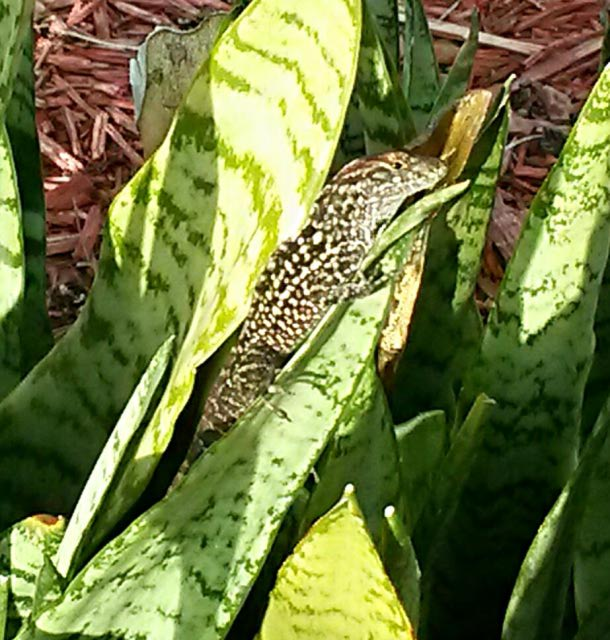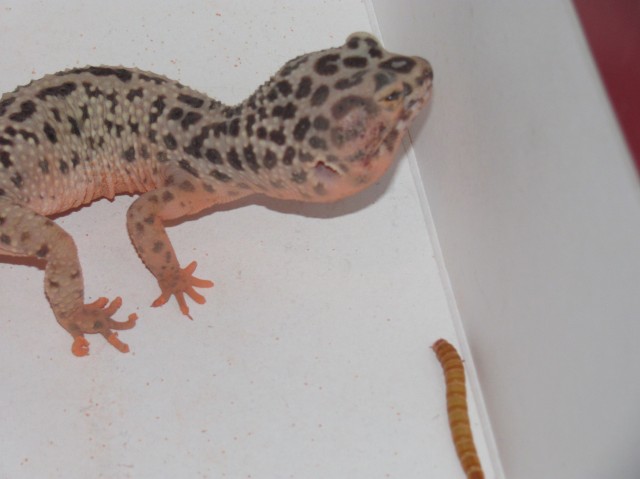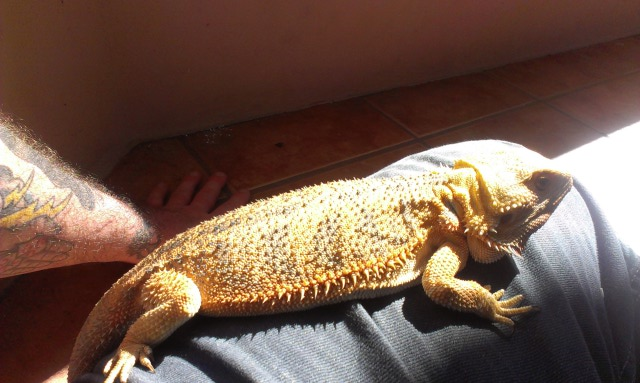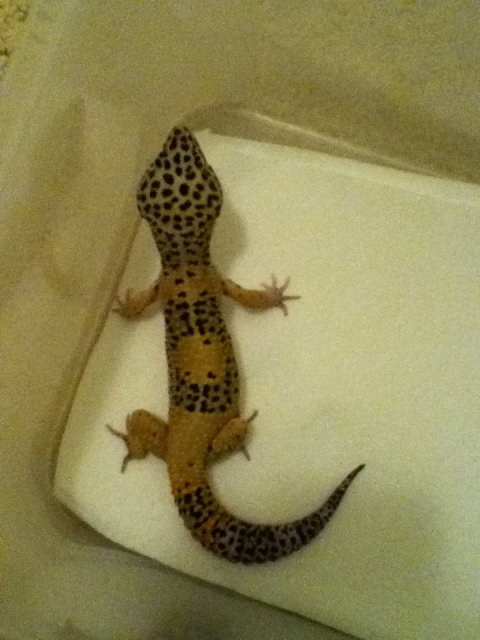QuestionI have a young adult male BD with at least one toe on each foot that is very swollen at the distal end. His feet are also rather "puffy". He is able to walk but not climb very well. This swelling has become apparent in the past 2 weeks.
He is housed in a 50 gal. fish tank, reptile carpet substrate, 10 uvb zoo med u-tube compact light and a 100w basking spotlamp. Both are in separate aluminum deep domes.The lights are both about 14" above him.
Basking temp is about 87 deg. with approx. 40% humidity & I spray him often. I offer him both mealworms, gut loaded crickets and lots of greens, mixed veggies, apples & squash diced up. I also suplement twice a week with a calcium powder with D3. I give him a 5 min warm bath daily.He just finished shedding in bits and pieces and last defecated 4 days ago. He usually does this about 2 to 3 times per week. He is offered water in a i inch deep water dish that is changed daily. He was captive bred. I've tried to supply all that you have asked for here and would like to thank you for your time and interest in offering suggestions.
Thank you.....Rich
AnswerSounds like possibly gout or pseudogout, due to excessive animal protein or excessive calcium and D3 intake. Gout causes uricemia crystallization in joint tissues, and pseudogout causes calcification.
This may also be due to retained shed on the toes cutting off circulation, which can lead to loss of toes and infection. So, I would urge to you inspect the feet carefully for retained shed first and obvious trauma. If that is clear, then you need to get him into a vet for a blood panel for Blood-Urea-Nitrate, liver enzymes, kidney function, and serum Ca. & P levels, in order to check for gout/pseudogout.
If he is suffering one of these metabolic disorders, it causes a lot of pain, possible kidney stones, loss of digits or limb, joint destruction, subsequent infection, or organ failure ( liver and kidney failure ) which can be fatal. Gout and pseudogout show symptoms in the joints, but they also affect the organs such as liver, spleen, and kidneys as well.
In the meantime:
1. Reduce protein intake as excess purines will build up uric acid in the blood and more crystallization in the joints and soft tissues. Cut out the mealworms and other excessively fatty feeders right now.
2. Cut veggies high in oxalic acid ( oxalate ) such as spinach, and high purine rich asparagus, and cauliflower; which will just further acidify the blood. Some say plant based purines may not be responsible for contributing to gout, but it can't help to avoid them and use other available items right now.
3. Give extra hydration. Extra hydration.
4. Boost your basking temps. They are too low for a Beardie. Their digestive and immune system does not operate well if under temp. Get it up in the high 90s right under the basking area, and provide a cooler spot in the mid-low 80s on the other side.
5. Cut the calcium supplementation until you get a hematology from the vet on serum Ca. Greens high in calcium is all he should need if he is eating well and getting proper lighting. I doubt he is suffering from low blood calcium at all given the calcium supplements. Unless you are giving excess oxalates and fat that have interfered with Ca. absorption.
6. Cut out the D3 supplementation entirely, even after this condition passes. The average person should not even be using active D3. That stuff ( Cholecalciferol ) is used in rat poison too- by causing hypercalcemia!
D3 is also a hormone, and hormones should not be given without complete understanding of their effects on signaling metabolic functions, such as higher absorption of Ca. from the digestive system when it is not needed, thereby increasing serum Ca.
All D3 powder does is bypass normal biological synthesis where the lizard generates and stores their own D3 as needed. There is too much risk of overdosing, and causing a condition such as the one you are seeing, by using a short cuts such as D3 powder. Excess Calcium/D3 powder could in fact be the sole cause here.
Stick to good diet and good UVB lighting and the animal will do the rest naturally. If you want to offer supplemental Ca., do it in a calcium carbonate only form, and no more than once a week is plenty. I offer such dustings probably only once or twice a month myself. The kidneys can only excrete so much Ca., and excess causes a rise in serum Ca., which can then lead to pseudogout, as what cannot be excreted is then deposited.
7. GET RID OF THAT COMPACT COIL UVB LAMP!! They are dangerous for more than reason. The ZooMed and R-Zilla have been reported in numerous cases of severe eye injury in herps due to defective manufacturing which allowed near UVC transmission, causing photo-kerato-conjunctivitis.
Besides, compact coils are pure junk and you are flirting with eventual MBD by relying on one of those cheap things. Get something like a Mega-Ray SB mercury vapor instead, or at the very least, a linear UVB tube and change it every 6-8 months. The compact coil, by nature of their very designs, block most of the useable UVB transmitted. When it's all wound up like that instead of transmitted in linear fashion, it's just a waste of UVB. Their cheaper prices saves nothing.
====================================================
If the Beardie's diagnosis is due to a gouty condition, the vet may need to perform a joint aspiration to identify the crystals and perform injection of corticosteroid to reduce inflammation. Allopurinol or Colchicine may also be useful. In the case of gout, I have also recommended natural anti-inflammatories and/or substances with diuretic properties; such as celery seed, folic acid, quercetin, sodium bicarbonate, and vitamin C. Potassium and sodium supple-mentation may be necessary additionally. These should not be used without consultation however, as rapid changes in blood chemistry can also lead to more severe attacks, and unskilled use can easily lead to an OD if you don't know how much to administer. This includes rapid changes due to diuretic action.
Phosphate binders may be necessary if serum P. is high due to renal failure. The Beardie should be leaving regular yellowish-white urate crystals every day or two. If not, if they are too small, or if the crystals are too yellow or brownish colored, then there is a problem. Only problem with phosphate binders is that some should not be used in cases of renal failure, and the one that can, calcium, really shouldn't be used if this gouty condition is due to hypercalcemia.
====================================================
Notes on your diet:
I'm not a fan of mealworms used too often. Too fatty and too high in chitin, sodium, and phosphorous...whether gut loaded or not. They aren't that great to start with, and that's why they are cheap.
No larvae invertebrate is really that great as a feeder, but I would recommend using something a little better in the diet, such as: waxworm, butterworm, phoenix worms, etc. Not as a staple, but as a supplement. Mealworms are also more responsible for gastric impactions than most other feeders.
Excessively fatty meals can lead to fatty liver disease and metabolic bone disorder by interfering with Ca. absorption.
http://anapsid.org ( browse this site thoroughly for more on
metabolic disorders )
http://beardeddragon.org

 species identification
Question
unknown
I live in Cape Coral Southwest
species identification
Question
unknown
I live in Cape Coral Southwest
 leopard Gecko with a swollen right eye
QuestionQUESTION: My daughter has about a 6-8 year old
leopard Gecko with a swollen right eye
QuestionQUESTION: My daughter has about a 6-8 year old
 Bearded Dragon - health/appetite
QuestionQUESTION: I have a 3 year old bearded dragon. S
Bearded Dragon - health/appetite
QuestionQUESTION: I have a 3 year old bearded dragon. S
 sailfin dragon behaving strange
Questionsailfin dragon
QUESTION: My sailfin drag
sailfin dragon behaving strange
Questionsailfin dragon
QUESTION: My sailfin drag
 Leopard Gecko concerns
QuestionKobi
Kobis Eye
QUESTION: Hi, I
Leopard Gecko concerns
QuestionKobi
Kobis Eye
QUESTION: Hi, I